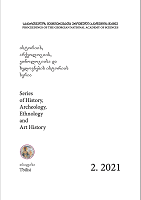საქართველო და „აბრეშუმის დიდი გზა“ გვიანანტიკურ ხანასა და შუა საუკუნეებში
Georgia and the great silk road in late antiquity and the middle ages
Author(s): Lia GablishviliSubject(s): Archaeology, Cultural history, Economic history, History of ideas, Social history, Ancient World, 6th to 12th Centuries
Published by: საქართველოს მეცნიერებათა ეროვნული აკადემიის გამომცემლობა
Keywords: Silk Road; China; Caucasus; Georgia; Byzantine Empire;
Summary/Abstract: The article focuses on the materials covering the operation of the Great Silk Road, the routes thereof, as well as Georgia’s involvement in trade relations between East and West carried out through this large-scale international major artery. Georgia had been involved in the international trade long before the emergence of the Great Silk Road. There had been reports on Greek imports in Colchis and Iberia as early as in the archaic and classical periods. It had contributed to the development of the roads that later became part of the Great Silk Road. The article offers the analysis of the data provided by Patroclus, Strabo, Marcus Terentius Varro, Menander, Pei Zui (a Chinese historian) and others. Iran and the Byzantine Empire had been engaged in wars to dominate the roads crossing the North Caucasus for centuries. It is noteworthy that starting from the second half of the sixth century, the main traffic transit load fell on the Caucasus section of the Silk Road, whereas at the end of the sixth century the North Caucasus direction eventually became a regularly operating main trade route. Archaeological excavations have revealed that the Chinese traders themselves used to travel along this route. An entire complex of Chinese items, including the fragments of Chinese embroidered silk and personal trade record of the merchant, dating back to the Tang era was found in a tomb located in the upper reaches of the Bolshaya Laba river, a tributary of the Kuban River. Alongside the Chinese textile, Chinese porcelain was also imported from the Far East to the West through Asia Minor. This is evidenced by the so-called ‘Celadons’, the fragments of which were found during the excavations in the large trading city of Anisi and the city of Dmanisi. This particular type of Chinese porcelain was made in the twelfth- thirteenth centuries. The only Chinese coin dating back to the 1200, which was found in Mtskheta in 1993, is also of particular importance.
- Issue Year: 2021
- Issue No: 2
- Page Range: 26-47
- Page Count: 22
- Language: Georgian

